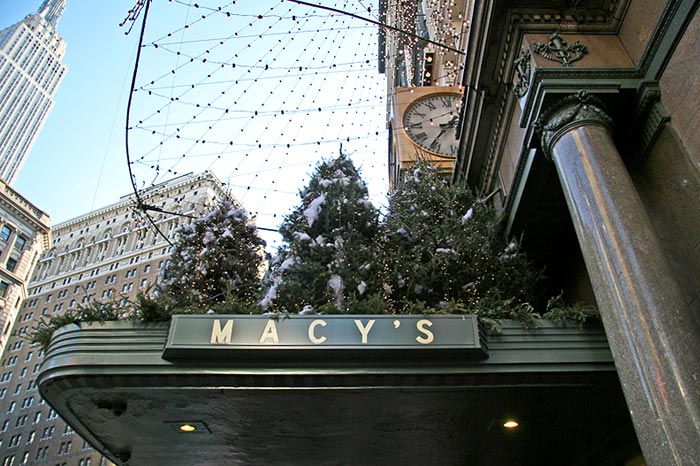 There is probably no store more commonly associated with NYC than Macy's. Present in film (Miracle on 34th Street) and other media, sponsor of the annual Thanksgiving Day parade, the annual fireworks display (since 1976), Macy's has been around for nearly 150 years. It was established as a dry goods store in 1858 on 14th Street and 6th Avenue, then moved to 18th Street and Broadway (on the Ladies Mile) for 40 years, and came to rest in 1902 at its current location at Herald Square (34th Street and Broadway). Click here for more photos. The company went public in 1922 and subsequently expanded to locations across the country (it now has over 800 stores). It was the first store to use escalators - the original wood escalators are still in use. Macy's is part of the fabric of New York City - like Central Park, Times Square, Grand Central Station and the Empire State Building, it is nearly impossible to conceive of the city without it. Although it is a place a business, I think it has a different meaning in the hearts and minds of most New Yorkers than any other store. In 1992, Macy's actually filed for bankruptcy and icon or not, any seasoned citizen knew that nothing is guaranteed and Macy's survival was in real jeopardy. They survived and merged with Federated Department Stores. Many internationally known businesses have gone under that may at one time been considered invulnerable such as Pan Am ...
There is probably no store more commonly associated with NYC than Macy's. Present in film (Miracle on 34th Street) and other media, sponsor of the annual Thanksgiving Day parade, the annual fireworks display (since 1976), Macy's has been around for nearly 150 years. It was established as a dry goods store in 1858 on 14th Street and 6th Avenue, then moved to 18th Street and Broadway (on the Ladies Mile) for 40 years, and came to rest in 1902 at its current location at Herald Square (34th Street and Broadway). Click here for more photos. The company went public in 1922 and subsequently expanded to locations across the country (it now has over 800 stores). It was the first store to use escalators - the original wood escalators are still in use. Macy's is part of the fabric of New York City - like Central Park, Times Square, Grand Central Station and the Empire State Building, it is nearly impossible to conceive of the city without it. Although it is a place a business, I think it has a different meaning in the hearts and minds of most New Yorkers than any other store. In 1992, Macy's actually filed for bankruptcy and icon or not, any seasoned citizen knew that nothing is guaranteed and Macy's survival was in real jeopardy. They survived and merged with Federated Department Stores. Many internationally known businesses have gone under that may at one time been considered invulnerable such as Pan Am ...
Stories of the ordinary, the extraordinary, the classic,
the unexpected and the hidden gems
by a long time resident who shares his love of New York City.
New York Daily Photo Analytics
Sunday, December 31, 2006
Macy's
 There is probably no store more commonly associated with NYC than Macy's. Present in film (Miracle on 34th Street) and other media, sponsor of the annual Thanksgiving Day parade, the annual fireworks display (since 1976), Macy's has been around for nearly 150 years. It was established as a dry goods store in 1858 on 14th Street and 6th Avenue, then moved to 18th Street and Broadway (on the Ladies Mile) for 40 years, and came to rest in 1902 at its current location at Herald Square (34th Street and Broadway). Click here for more photos. The company went public in 1922 and subsequently expanded to locations across the country (it now has over 800 stores). It was the first store to use escalators - the original wood escalators are still in use. Macy's is part of the fabric of New York City - like Central Park, Times Square, Grand Central Station and the Empire State Building, it is nearly impossible to conceive of the city without it. Although it is a place a business, I think it has a different meaning in the hearts and minds of most New Yorkers than any other store. In 1992, Macy's actually filed for bankruptcy and icon or not, any seasoned citizen knew that nothing is guaranteed and Macy's survival was in real jeopardy. They survived and merged with Federated Department Stores. Many internationally known businesses have gone under that may at one time been considered invulnerable such as Pan Am ...
There is probably no store more commonly associated with NYC than Macy's. Present in film (Miracle on 34th Street) and other media, sponsor of the annual Thanksgiving Day parade, the annual fireworks display (since 1976), Macy's has been around for nearly 150 years. It was established as a dry goods store in 1858 on 14th Street and 6th Avenue, then moved to 18th Street and Broadway (on the Ladies Mile) for 40 years, and came to rest in 1902 at its current location at Herald Square (34th Street and Broadway). Click here for more photos. The company went public in 1922 and subsequently expanded to locations across the country (it now has over 800 stores). It was the first store to use escalators - the original wood escalators are still in use. Macy's is part of the fabric of New York City - like Central Park, Times Square, Grand Central Station and the Empire State Building, it is nearly impossible to conceive of the city without it. Although it is a place a business, I think it has a different meaning in the hearts and minds of most New Yorkers than any other store. In 1992, Macy's actually filed for bankruptcy and icon or not, any seasoned citizen knew that nothing is guaranteed and Macy's survival was in real jeopardy. They survived and merged with Federated Department Stores. Many internationally known businesses have gone under that may at one time been considered invulnerable such as Pan Am ...
Saturday, December 30, 2006
Re-Creation
 This is the home of the Tenth Church of Christ Scientist at 171 MacDougal Street as seen from MacDougal Alley. This austere, modernist structure with no windows has always seemed out of place in the heart of the Greenwich Village historic district. As one might suspect, there is more here than meets the eye. As it turns out, the building itself was designed in 1890 by Renwick, Aspinwall and Russell. The factory building was acquired by the Church in 1921 and in 1966, the building's facade was radically altered to its current condition by Victor Christ-Janer & Associates. What's exciting for the neighborhood is that a proposal was made in April, 2006 (and approved in June) to restore the building's facade to its historic Romanesque-style. There will be three bays of windows with arched windows on the next to highest floor and smaller windows on the top floor. Overall, it's a huge improvement for such a prominent location and has been applauded by the community. The upper floors (which have been unused since the alteration) will be converted to 9 residential condominiums. Unlike most churches with various activities, this building has always been eerily quiet, with rare signs of life. Perhaps with all the new windows, we will finally see what's really going on in there :)
This is the home of the Tenth Church of Christ Scientist at 171 MacDougal Street as seen from MacDougal Alley. This austere, modernist structure with no windows has always seemed out of place in the heart of the Greenwich Village historic district. As one might suspect, there is more here than meets the eye. As it turns out, the building itself was designed in 1890 by Renwick, Aspinwall and Russell. The factory building was acquired by the Church in 1921 and in 1966, the building's facade was radically altered to its current condition by Victor Christ-Janer & Associates. What's exciting for the neighborhood is that a proposal was made in April, 2006 (and approved in June) to restore the building's facade to its historic Romanesque-style. There will be three bays of windows with arched windows on the next to highest floor and smaller windows on the top floor. Overall, it's a huge improvement for such a prominent location and has been applauded by the community. The upper floors (which have been unused since the alteration) will be converted to 9 residential condominiums. Unlike most churches with various activities, this building has always been eerily quiet, with rare signs of life. Perhaps with all the new windows, we will finally see what's really going on in there :)
Friday, December 29, 2006
Saks Fifth Avenue
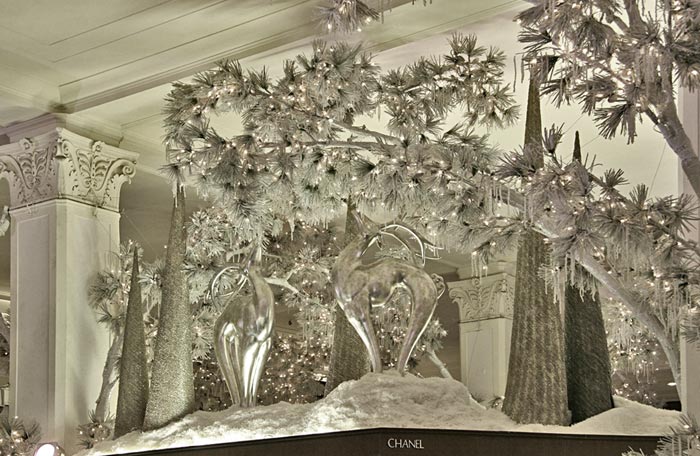 Previously I featured the Christmas window displays at Saks Fifth Avenue. This is the season's store interior - click here for more photos - isn't it magnificent? I complemented the staff on the design and execution - they were so friendly with no issues whatsoever taking photos (this is not always the case - I was reprimanded at Sephora at the Scribner location). In fact they were very excited, took my card and promised to check out the photoblog. I was informed that Saks has its own in house visual design staff. I am not a shopper at all, but this is the type of decor that inspires one to explore the high end retailers. Click here for an exterior photo showing their snowflake lighting. If you are at all interested in NYC, visiting stores and its neighbors along Fifth Avenue is a must at least once in your life. A nice walk would be to start 59th Street (Central Park, Plaza Hotel, Apple Store, Fao Schwartz) and stroll down 5th Avenue ending at 42nd Street at the main branch of the New York Public Library ...
Previously I featured the Christmas window displays at Saks Fifth Avenue. This is the season's store interior - click here for more photos - isn't it magnificent? I complemented the staff on the design and execution - they were so friendly with no issues whatsoever taking photos (this is not always the case - I was reprimanded at Sephora at the Scribner location). In fact they were very excited, took my card and promised to check out the photoblog. I was informed that Saks has its own in house visual design staff. I am not a shopper at all, but this is the type of decor that inspires one to explore the high end retailers. Click here for an exterior photo showing their snowflake lighting. If you are at all interested in NYC, visiting stores and its neighbors along Fifth Avenue is a must at least once in your life. A nice walk would be to start 59th Street (Central Park, Plaza Hotel, Apple Store, Fao Schwartz) and stroll down 5th Avenue ending at 42nd Street at the main branch of the New York Public Library ...
Thursday, December 28, 2006
Terra Blues
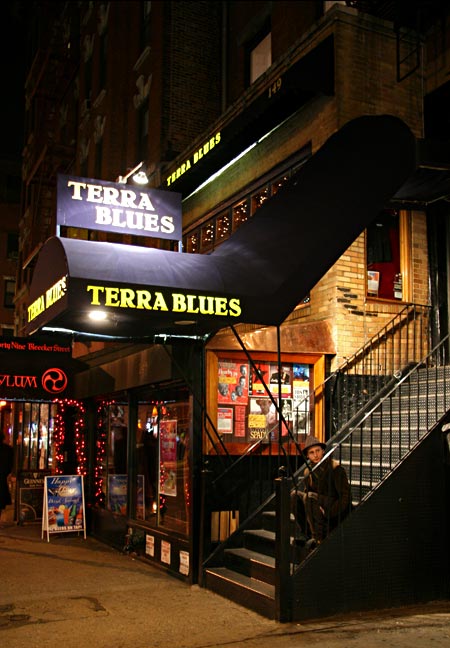 Many small music clubs have closed down over the years - rising rents in Manhattan is certainly one of the major factors. And hit hardest are those clubs featuring less popular genres such as the blues. Important venues like Chicago Blues and Manny's Car Wash have closed. The only real blues venue left in Manhattan is Terra Blues (B.B. King has a blues room). Terra Blues is one flight up at 149 Bleecker Street (click here for 2nd photo) - one of the most touristy and well known streets in the Village. However, this club is authentic and gets serious acts. And unlike many remaining music clubs in the city, it is quite reasonable - the cover charge varies; many weeknights there is no cover or minimum. If you like blues at all, I highly recommend it. Check the calendar on their website. One of my favorite blues musicians is harmonica player Jason Ricci. Here's a link to his mypace site and his website. Jason has started playing at Terra Blues - keep an eye out for him ...
Many small music clubs have closed down over the years - rising rents in Manhattan is certainly one of the major factors. And hit hardest are those clubs featuring less popular genres such as the blues. Important venues like Chicago Blues and Manny's Car Wash have closed. The only real blues venue left in Manhattan is Terra Blues (B.B. King has a blues room). Terra Blues is one flight up at 149 Bleecker Street (click here for 2nd photo) - one of the most touristy and well known streets in the Village. However, this club is authentic and gets serious acts. And unlike many remaining music clubs in the city, it is quite reasonable - the cover charge varies; many weeknights there is no cover or minimum. If you like blues at all, I highly recommend it. Check the calendar on their website. One of my favorite blues musicians is harmonica player Jason Ricci. Here's a link to his mypace site and his website. Jason has started playing at Terra Blues - keep an eye out for him ...
Wednesday, December 27, 2006
Nokia Store
 In the most upscale shopping district of Manhattan, on September 9th, Nokia opened its second retail store in the US after Chicago (and 5th in the world). Click here for more photos. The store is sandwiched between luxury retailers in a compact, 1,800 square foot, three-level building at 5 East 57th Street. With neighbors like Bulgari, Burberry, Louis Vuitton, Prada and Tiffany, the flagship store appears to be less about actual retailing and more about exposure. The translucent walls change colors, approximately 60 different hues throughout the day. Nokia has created an interactive, multimedia environment. Phones are for sale in the store from $99 to $150,000. The Vertu brand boutique is on the 3rd floor with cell phones with laser etched keys, sapphire crystal screens, or ostrich leather cases. Here's a link to their original press release, with details about the store. The environment is low key with no pressure - the sales staff does not work on commission ...
In the most upscale shopping district of Manhattan, on September 9th, Nokia opened its second retail store in the US after Chicago (and 5th in the world). Click here for more photos. The store is sandwiched between luxury retailers in a compact, 1,800 square foot, three-level building at 5 East 57th Street. With neighbors like Bulgari, Burberry, Louis Vuitton, Prada and Tiffany, the flagship store appears to be less about actual retailing and more about exposure. The translucent walls change colors, approximately 60 different hues throughout the day. Nokia has created an interactive, multimedia environment. Phones are for sale in the store from $99 to $150,000. The Vertu brand boutique is on the 3rd floor with cell phones with laser etched keys, sapphire crystal screens, or ostrich leather cases. Here's a link to their original press release, with details about the store. The environment is low key with no pressure - the sales staff does not work on commission ...
Tuesday, December 26, 2006
The Crown Building
 The Crown Building, at 730 Fifth Avenue and 57th Street, has one of midtown Manhattan's finest roofs. When seen at night, its illuminated, striking 416-foot high crown with gilded details truly gives it a regal quality, befitting of its name. The French Renaissance octagonal tower section is very striking, with stone/terra cotta, dormers, parapets and a huge chimney stack. An original weathervane in the form of a rooster was removed in 1942 and melted down as part of the war effort. The best unobstructed view is from the north, where this photo was taken. Designed by Warren and Wetmore and built in 1921, it was one of the first buildings to go up after the setback provisions of the 1916 Zoning Resolution. It was originally called the Hecksher Building after its developer August Hecksher, a German immigrant (1867) who made his wealth from mining operations. In 1929, the Museum of Modern Art opened its first gallery here in rented rooms on the 12th floor. In the 1960s it was known as the Genesco Building and again renamed in 1983 as the Crown Building and in the 1980s became one of the properties of the Marcos of the Philippines. One of the early commercial developments on the Vanderbilt's former turf, Hecksher's vision was quite prescient: "In the last analysis, whoever will not shop on Fifth Avenue and 57th Street will not shop anywhere."
The Crown Building, at 730 Fifth Avenue and 57th Street, has one of midtown Manhattan's finest roofs. When seen at night, its illuminated, striking 416-foot high crown with gilded details truly gives it a regal quality, befitting of its name. The French Renaissance octagonal tower section is very striking, with stone/terra cotta, dormers, parapets and a huge chimney stack. An original weathervane in the form of a rooster was removed in 1942 and melted down as part of the war effort. The best unobstructed view is from the north, where this photo was taken. Designed by Warren and Wetmore and built in 1921, it was one of the first buildings to go up after the setback provisions of the 1916 Zoning Resolution. It was originally called the Hecksher Building after its developer August Hecksher, a German immigrant (1867) who made his wealth from mining operations. In 1929, the Museum of Modern Art opened its first gallery here in rented rooms on the 12th floor. In the 1960s it was known as the Genesco Building and again renamed in 1983 as the Crown Building and in the 1980s became one of the properties of the Marcos of the Philippines. One of the early commercial developments on the Vanderbilt's former turf, Hecksher's vision was quite prescient: "In the last analysis, whoever will not shop on Fifth Avenue and 57th Street will not shop anywhere."
Monday, December 25, 2006
Santa
 Everyone knows there are lots of Santa's helpers around the world. But we also know that there is only one real Santa. And where is he? - 34th Street and Broadway, of course, at Macys - on the 8th Floor in Santaland (A mere glance at the quality of Santa's wardrobe should alleviate any doubts.) Click here for photos of Santaland. The lines were long, and I thought it was a good idea to leave sitting on Santa's lap and gift wishing to the younger ones. So, I opted to go to the line where one could get a peek at Santa - he was behind glass, hence the reflections.
Everyone knows there are lots of Santa's helpers around the world. But we also know that there is only one real Santa. And where is he? - 34th Street and Broadway, of course, at Macys - on the 8th Floor in Santaland (A mere glance at the quality of Santa's wardrobe should alleviate any doubts.) Click here for photos of Santaland. The lines were long, and I thought it was a good idea to leave sitting on Santa's lap and gift wishing to the younger ones. So, I opted to go to the line where one could get a peek at Santa - he was behind glass, hence the reflections.
Sunday, December 24, 2006
Saks Windows
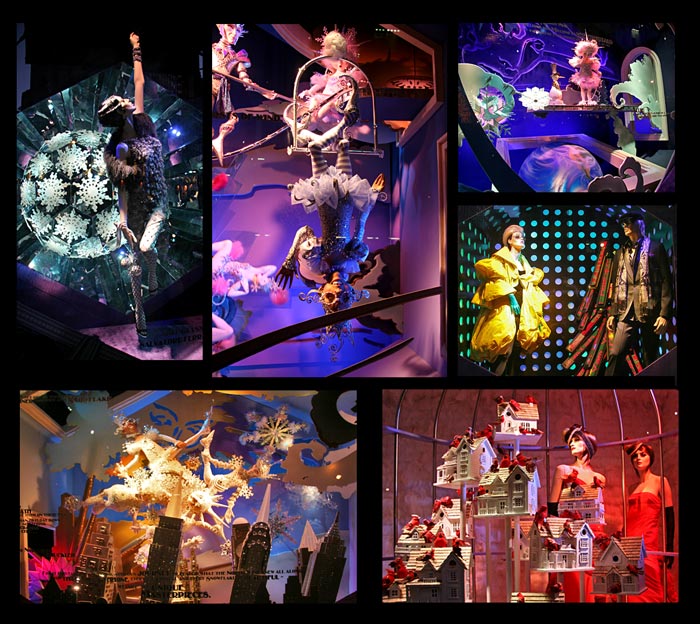 These are the window displays at Saks. I created a collage - it was too difficult to pick one photo. To see the entire window display set, click here. They are the windows I always associate with Christmas in New York - beautifully done, themed, on Fifth Avenue near all the flagship stores and St. Patricks, facing Rock Center and the big Tree. You wait in line to see the windows, but no one seems to complain. Moving slowly is welcome and gives more time to enjoy them. The in house visual creative staff creates these windows - the primary group has a storyline about outsider crystals finally joining together to become a unified snowflake. Christmas has become an extremely commercial holiday. But, no matter how jaded one becomes, frustrated with the crowds and traffic, or how disappointed one gets with the commercialism of Christmas, one should try not to become a bitter malcontent. Leave a place for sentiment, giving, nostalgia, and joy ...
These are the window displays at Saks. I created a collage - it was too difficult to pick one photo. To see the entire window display set, click here. They are the windows I always associate with Christmas in New York - beautifully done, themed, on Fifth Avenue near all the flagship stores and St. Patricks, facing Rock Center and the big Tree. You wait in line to see the windows, but no one seems to complain. Moving slowly is welcome and gives more time to enjoy them. The in house visual creative staff creates these windows - the primary group has a storyline about outsider crystals finally joining together to become a unified snowflake. Christmas has become an extremely commercial holiday. But, no matter how jaded one becomes, frustrated with the crowds and traffic, or how disappointed one gets with the commercialism of Christmas, one should try not to become a bitter malcontent. Leave a place for sentiment, giving, nostalgia, and joy ...
Saturday, December 23, 2006
National Tree
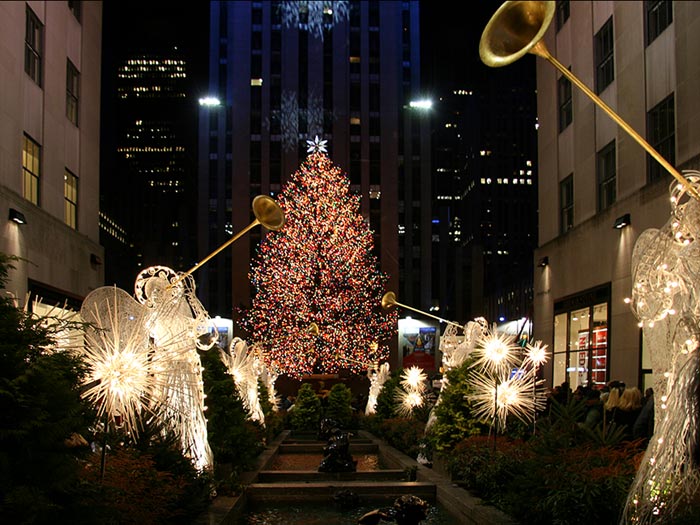 There are millions of Christmas trees in the US, but arguably the one at Rockefeller Center is the Unofficial National Tree. Click here for more photos. In a tradition that goes back to 1933, a near perfect tree is selected - nearly always a Norway Spruce, a non-native ornamental tree with a typical lifespan of 80-100 years. Growers who hope theirs will be selected submit photos; the top selections are surveyed and inspected by helicopter. The preferred tree is 75 to 90 feet tall and typically over 50 years old. This year's Norway Spruce is from the property of Rob Kinnaird in Ridgefield, Connecticut, who watched it growing up - their driveway was moved 4 times over the years to accommodate its growth. This year's tree is 88 feet tall, 45 feet in diameter and weighs 9 tons. It was trucked to the city on a custom, telescoping trailer, decorated with 30,000 lights and crowned with a custom made, 9 foot, 550 pound Austrian Swarovski crystal top! The tree lighting ceremony on Nov. 29 was nationally televised and included Christina Aguilera, Bette Midler, Lionel Richie, Sarah McLachlan and Sting as guests. It will be up until January 9th ...
There are millions of Christmas trees in the US, but arguably the one at Rockefeller Center is the Unofficial National Tree. Click here for more photos. In a tradition that goes back to 1933, a near perfect tree is selected - nearly always a Norway Spruce, a non-native ornamental tree with a typical lifespan of 80-100 years. Growers who hope theirs will be selected submit photos; the top selections are surveyed and inspected by helicopter. The preferred tree is 75 to 90 feet tall and typically over 50 years old. This year's Norway Spruce is from the property of Rob Kinnaird in Ridgefield, Connecticut, who watched it growing up - their driveway was moved 4 times over the years to accommodate its growth. This year's tree is 88 feet tall, 45 feet in diameter and weighs 9 tons. It was trucked to the city on a custom, telescoping trailer, decorated with 30,000 lights and crowned with a custom made, 9 foot, 550 pound Austrian Swarovski crystal top! The tree lighting ceremony on Nov. 29 was nationally televised and included Christina Aguilera, Bette Midler, Lionel Richie, Sarah McLachlan and Sting as guests. It will be up until January 9th ...
Friday, December 22, 2006
11 Spring Street
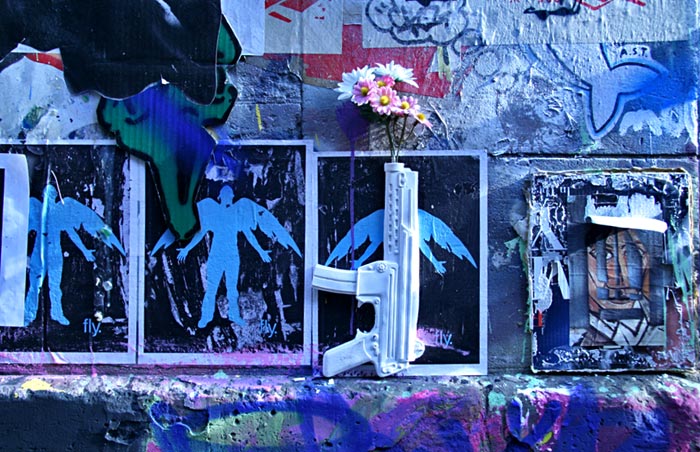 The mysterious former carriage and horse stable at 11 Spring Street has been (virtually) unoccupied for decades. Click here for more photos. Built in 1888, its most famous owner was John Simpson who purchased the building in the 1970s. An eccentric inventor, Simpson lived in the massive 5 story building alone with his bizarre mechanical gadgets. In 2003 the building was sold to Lachlan Murdoch, son of media mogul Rupert Murdoch, with the intention of converting it into a spectacular single family residence. Left to languish again, the building was again sold, this time to developers Caroline Cummings and Bob Elias - it will be converted to luxury condominiums. During all this time, graffiti accumulated on the exterior walls. The place became "known worldwide as a mecca for street artists, some of whom have covered its sooty facade with a pastiche of graffiti and poster art." The new owners wanted to pay tribute to the street art, so they arranged a gala "grand closing" with the Wooster Collective, called Wooster on Spring. Forty five of the world's best street artists were invited to cover the walls of all five floors with artwork. After two months, the show was opened to the public for three days - December 15, 16 and 17, after which all the art was to be destroyed. It was an unbelievable mob scene - lines to get in going around a full city block with a 3-4 hour wait. The Gothamist did an extensive job of covering this story and I recommend this link (and the various links there) to see photos of the interior art ...
The mysterious former carriage and horse stable at 11 Spring Street has been (virtually) unoccupied for decades. Click here for more photos. Built in 1888, its most famous owner was John Simpson who purchased the building in the 1970s. An eccentric inventor, Simpson lived in the massive 5 story building alone with his bizarre mechanical gadgets. In 2003 the building was sold to Lachlan Murdoch, son of media mogul Rupert Murdoch, with the intention of converting it into a spectacular single family residence. Left to languish again, the building was again sold, this time to developers Caroline Cummings and Bob Elias - it will be converted to luxury condominiums. During all this time, graffiti accumulated on the exterior walls. The place became "known worldwide as a mecca for street artists, some of whom have covered its sooty facade with a pastiche of graffiti and poster art." The new owners wanted to pay tribute to the street art, so they arranged a gala "grand closing" with the Wooster Collective, called Wooster on Spring. Forty five of the world's best street artists were invited to cover the walls of all five floors with artwork. After two months, the show was opened to the public for three days - December 15, 16 and 17, after which all the art was to be destroyed. It was an unbelievable mob scene - lines to get in going around a full city block with a 3-4 hour wait. The Gothamist did an extensive job of covering this story and I recommend this link (and the various links there) to see photos of the interior art ...
Thursday, December 21, 2006
Museum of Sex
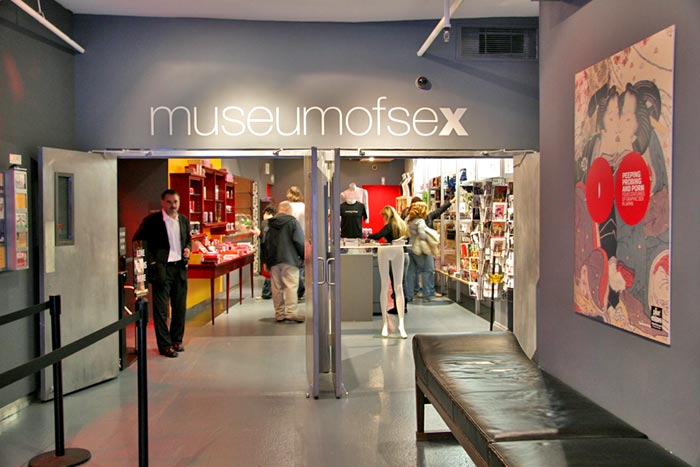 This is one of the most fascinating stories I've read in a long time. MoSex, located at 27th Street and 5th Avenue, occupies two floors of a 5-storey building that reputedly was a brothel. Then there was the denial by the Board of Regents to charter it as a cultural nonprofit organization, saying that a "museum of sex" made "a mockery" of the concept of museums. And of course, the controversy: immediately after opening in 2002, William Donohue of the Catholic League, condemning it as MoSmut, said "If the museum's officials were honest, they would include a death chamber that would acknowledge all the wretched diseases that promiscuity has caused." The museum is "wholly dedicated to the exploration of the history, evolution and cultural significance of human sexuality" according to the mission statement of founder Daniel Gluck, who has endeavored to give the museum an educational format. Gluck, a suburban family man, is a fine arts graduate of UPenn with a business degree from the Wharton School. The executive curator, Grady Turner, was a former director of exhibits at the New York Historical Society. There are 18 PhDs on the board of advisors. He accepted no funding from anyone in the porn industry. Still, the content is explicit and visitors must be 18. Exhibits include photos, film, porn, BDSM, Lesbian and Gay history, erotica, fetishism and history - like that of Julius Schmid, an impoverished German-Jewish immigrant, who in the 1880s, turned from sausage making to condoms, (illegal but later widely sold under the Ramses brand name) - read here. The museum acquired the collection of Ralph Whittington, a retired curator who worked at the Library of Congress for 36 years and had collected and documented pornography since the 1970s - click here for article. The collection includes more than four hundred 8-mm films, 700 videos, 1,500 magazines, 100 books, and artifacts (such as blow-up dolls and artificial genitalia). And at 57, he lived with his mother ...
This is one of the most fascinating stories I've read in a long time. MoSex, located at 27th Street and 5th Avenue, occupies two floors of a 5-storey building that reputedly was a brothel. Then there was the denial by the Board of Regents to charter it as a cultural nonprofit organization, saying that a "museum of sex" made "a mockery" of the concept of museums. And of course, the controversy: immediately after opening in 2002, William Donohue of the Catholic League, condemning it as MoSmut, said "If the museum's officials were honest, they would include a death chamber that would acknowledge all the wretched diseases that promiscuity has caused." The museum is "wholly dedicated to the exploration of the history, evolution and cultural significance of human sexuality" according to the mission statement of founder Daniel Gluck, who has endeavored to give the museum an educational format. Gluck, a suburban family man, is a fine arts graduate of UPenn with a business degree from the Wharton School. The executive curator, Grady Turner, was a former director of exhibits at the New York Historical Society. There are 18 PhDs on the board of advisors. He accepted no funding from anyone in the porn industry. Still, the content is explicit and visitors must be 18. Exhibits include photos, film, porn, BDSM, Lesbian and Gay history, erotica, fetishism and history - like that of Julius Schmid, an impoverished German-Jewish immigrant, who in the 1880s, turned from sausage making to condoms, (illegal but later widely sold under the Ramses brand name) - read here. The museum acquired the collection of Ralph Whittington, a retired curator who worked at the Library of Congress for 36 years and had collected and documented pornography since the 1970s - click here for article. The collection includes more than four hundred 8-mm films, 700 videos, 1,500 magazines, 100 books, and artifacts (such as blow-up dolls and artificial genitalia). And at 57, he lived with his mother ...Wednesday, December 20, 2006
St. Patrick's Cathedral
 St. Patrick's is the largest Gothic Catholic cathedral in the United States. It was designed by James Renwick, based on French Gothic, and built over a substantial period of time, from 1858-1879, with the towers added in 1888. The cathedral and its ancillary buildings occupy an entire city block, spanning from 50th to 51st Street, 5th Avenue to Madison Avenue. Interestingly, at the time of its construction under the stewardship of Archbishop John Hughes, the proposed site was ridiculed as "Hughes Folly" - the area was a near wilderness, with slaughter houses and cattle yards. Hughes persisted, believing that this site would one day be "in the heart of the city." The Cathedral is obviously a huge subject with many famed features - its pieta, burial crypt, organs, stained glass, altars, and architectural details. So if you are interested in learning more, I leave it to you to explore online and, of course, to visit in person...
St. Patrick's is the largest Gothic Catholic cathedral in the United States. It was designed by James Renwick, based on French Gothic, and built over a substantial period of time, from 1858-1879, with the towers added in 1888. The cathedral and its ancillary buildings occupy an entire city block, spanning from 50th to 51st Street, 5th Avenue to Madison Avenue. Interestingly, at the time of its construction under the stewardship of Archbishop John Hughes, the proposed site was ridiculed as "Hughes Folly" - the area was a near wilderness, with slaughter houses and cattle yards. Hughes persisted, believing that this site would one day be "in the heart of the city." The Cathedral is obviously a huge subject with many famed features - its pieta, burial crypt, organs, stained glass, altars, and architectural details. So if you are interested in learning more, I leave it to you to explore online and, of course, to visit in person...
Tuesday, December 19, 2006
Apple and Sherry
 There are many recipes for Apple and Sherry, but this is my favorite:
There are many recipes for Apple and Sherry, but this is my favorite:In this version, we mix the magnificent Sherry Netherland Hotel (built 1927) at 781 Fifth Avenue and 59th Street with the new Apple Store's spiral staircase (add a pinch of the GM building on the right). This Apple Store, open 24/7, is the subject of a previous post (click here). For more photos, click here. Note: Look for ripple in the middle of the photo - that's the result of stirring ...
Monday, December 18, 2006
Charles Scribner
 This Beaux Arts masterpiece and designated NYC Landmark at 597 Fifth Avenue, was designed in 1912 by renowned American architect Ernest Flagg. It is a 10-story, French-inspired building with a limestone and ironwork facade. Click here for more photos. Flagg, who was married to Scribner's sister, received this design job as one of his first major commissions from Charles Scribner, who owned the publishing house Charles Scribner's & Sons. At the time of the building of the 5th Avenue structure, Scribner had reached the summit of publishing with authors like Edith Wharton, Henry James, Robert Louis Stevenson, Rudyard Kipling, Theodore Roosevelt, Thomas Wolfe, F. Scott Fitzgerald and Ernest Hemingway. Scribner was friends with many of these authors and brought out many of their seminal works. The space was occupied from 1984-88 by Rizzoli, then by Brentanos Bookshop. In 1996, Bennetton took over the space and opened its first US flagship store, completely restoring the space to its former glory - with renovations of spiral staircases, Caen stone finishes, glass brick flooring, Carrera marble grand staircase, skylight etc. It is now occupied by Sephora. The interior vaulted, space (with ceilings as high as 30 feet) was designed to feel like a small library. It's really one of the grandest interior spaces in NYC. Many do miss the bookstore - it was such a grand space for a noble pursuit. I suggest a visit ...
This Beaux Arts masterpiece and designated NYC Landmark at 597 Fifth Avenue, was designed in 1912 by renowned American architect Ernest Flagg. It is a 10-story, French-inspired building with a limestone and ironwork facade. Click here for more photos. Flagg, who was married to Scribner's sister, received this design job as one of his first major commissions from Charles Scribner, who owned the publishing house Charles Scribner's & Sons. At the time of the building of the 5th Avenue structure, Scribner had reached the summit of publishing with authors like Edith Wharton, Henry James, Robert Louis Stevenson, Rudyard Kipling, Theodore Roosevelt, Thomas Wolfe, F. Scott Fitzgerald and Ernest Hemingway. Scribner was friends with many of these authors and brought out many of their seminal works. The space was occupied from 1984-88 by Rizzoli, then by Brentanos Bookshop. In 1996, Bennetton took over the space and opened its first US flagship store, completely restoring the space to its former glory - with renovations of spiral staircases, Caen stone finishes, glass brick flooring, Carrera marble grand staircase, skylight etc. It is now occupied by Sephora. The interior vaulted, space (with ceilings as high as 30 feet) was designed to feel like a small library. It's really one of the grandest interior spaces in NYC. Many do miss the bookstore - it was such a grand space for a noble pursuit. I suggest a visit ...
Sunday, December 17, 2006
Dyker Lights
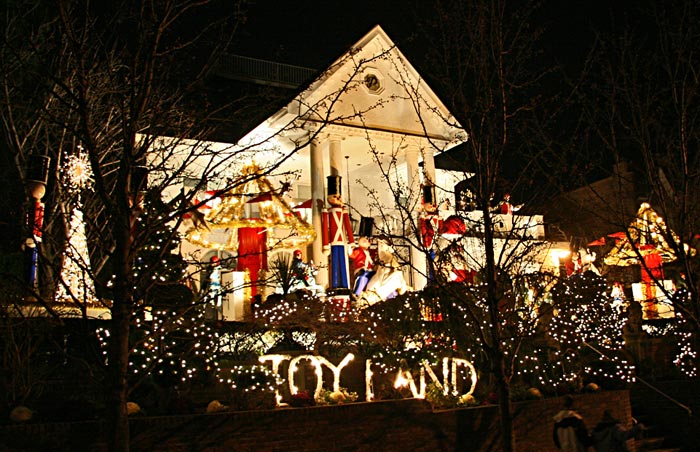 There are Christmas tree lights, and then there is Dyker Heights. This Brooklyn neighborhood (between Bayridge and Bensonhurst) is known worldwide for its elaborate Christmas light displays - click here for more photos. PBS did a 2001 documentary detailing the phenomenon. Apparently many of the displays have been motivated by various family events and crises. When I first visited this area in the 1980s, I had never seen anything remotely like it. The predominantly Italian neighborhood is quite affluent - many of the homes are mini-mansions. The premier block is 84th Street between 10th and 12th Avenue. Here, the traffic becomes bumper-to-bumper as gawkers cruise slowly down the block. In addition to the myriad of lights you will find: animated characters, motorized dolls, miniature villages, armies of illuminated soldiers and choirboys, live Santa, free toys, huge nativity scenes, synchronized music, and computerized displays like that of Robert DeLauro who, with Light-O-Rama software, a programmable microprocessor and computer in his basement, controls 10,000 lights using 32 extension cords. Apparently, extravagant computerized displays are becoming more common nationwide - check out the home displays on planetchristmas.com.
There are Christmas tree lights, and then there is Dyker Heights. This Brooklyn neighborhood (between Bayridge and Bensonhurst) is known worldwide for its elaborate Christmas light displays - click here for more photos. PBS did a 2001 documentary detailing the phenomenon. Apparently many of the displays have been motivated by various family events and crises. When I first visited this area in the 1980s, I had never seen anything remotely like it. The predominantly Italian neighborhood is quite affluent - many of the homes are mini-mansions. The premier block is 84th Street between 10th and 12th Avenue. Here, the traffic becomes bumper-to-bumper as gawkers cruise slowly down the block. In addition to the myriad of lights you will find: animated characters, motorized dolls, miniature villages, armies of illuminated soldiers and choirboys, live Santa, free toys, huge nativity scenes, synchronized music, and computerized displays like that of Robert DeLauro who, with Light-O-Rama software, a programmable microprocessor and computer in his basement, controls 10,000 lights using 32 extension cords. Apparently, extravagant computerized displays are becoming more common nationwide - check out the home displays on planetchristmas.com.
Saturday, December 16, 2006
Life at Night
 The New York Life Insurance Building has been described as limestone renaissance at the bottom and birthday cake at the top. This 1928, 40-story structure which towers over Madison Square Park at 51 Madison Avenue, was designed by Cass Gilbert, who had a love of pyramidal tops on his buildings - you see this in his Woolworth Building. The design is a fusion of gothic (there are 72 gargoyles at the roof line) with more modern elements. The New York Life was founded in 1845 and is the largest mutual life insurance company in the U.S. The famed gold top was built in 1967 and has been illuminated since 1985 on the company's 140th anniversary. In 1995, on the 150th anniversary, new gold leaf ceramic tiles were installed. The lit top is one of the major nighttime NYC icons which can be seen and easily identified from afar along with the Empire State Building, the Con Ed Tower, the Met Life Tower, the Citicorp Building and a handful of others.
The New York Life Insurance Building has been described as limestone renaissance at the bottom and birthday cake at the top. This 1928, 40-story structure which towers over Madison Square Park at 51 Madison Avenue, was designed by Cass Gilbert, who had a love of pyramidal tops on his buildings - you see this in his Woolworth Building. The design is a fusion of gothic (there are 72 gargoyles at the roof line) with more modern elements. The New York Life was founded in 1845 and is the largest mutual life insurance company in the U.S. The famed gold top was built in 1967 and has been illuminated since 1985 on the company's 140th anniversary. In 1995, on the 150th anniversary, new gold leaf ceramic tiles were installed. The lit top is one of the major nighttime NYC icons which can be seen and easily identified from afar along with the Empire State Building, the Con Ed Tower, the Met Life Tower, the Citicorp Building and a handful of others.BTW, the site for this building has a fascinating history - Union Depot, Gilmore's Garden, P.T. Barnum's Hippodrome and the original location for Madison Square Garden ...
Friday, December 15, 2006
Tongues and Flames
 When a friend and I on a photography shoot ran across this place, our reactions were the same - WHAT? Not only is the exterior unusual, but the business concept is also atypical. The Gershwin, at 7 E. 27th in the historic flatiron district, is a hybrid hotel and hostel, providing everything from 8-bedded rooms to more standard accommodations, even maintaining two separate websites (gershwinhotel.com and gershwinhostel.com). The fiberglass sconces on the facade were created by Finnish artist Stefan Lindfors who was asked to create something to distinguish the 1905 building. ''This hotel is always on fire,'' said Lindfor, who's piece is called Tongues and Flames. The entire hotel has created has created an atmosphere to cater to the young, chic, arty and European with the requisite amenities - internet access, The Living Room featuring jazz and comedy, an onsite gallery and a pop art adorned lobby with a signed Andy Warhol soup can ...
When a friend and I on a photography shoot ran across this place, our reactions were the same - WHAT? Not only is the exterior unusual, but the business concept is also atypical. The Gershwin, at 7 E. 27th in the historic flatiron district, is a hybrid hotel and hostel, providing everything from 8-bedded rooms to more standard accommodations, even maintaining two separate websites (gershwinhotel.com and gershwinhostel.com). The fiberglass sconces on the facade were created by Finnish artist Stefan Lindfors who was asked to create something to distinguish the 1905 building. ''This hotel is always on fire,'' said Lindfor, who's piece is called Tongues and Flames. The entire hotel has created has created an atmosphere to cater to the young, chic, arty and European with the requisite amenities - internet access, The Living Room featuring jazz and comedy, an onsite gallery and a pop art adorned lobby with a signed Andy Warhol soup can ...
Thursday, December 14, 2006
Left Bank New York
 From 1900-1950 there was a community of some 200 artists who lived and worked in the two blocks north of Washington Square. The artists' spaces, converted stables and townhouses, evoked the atmosphere of the Left Bank of Paris. Among the noted artists were: Paul Manship, Gertrude Vanderbilt Whitney, Gaston Lachaise, Isamu Noguchi and Edward Hopper. Virginia Budny has curated a new show (at NYU's La Maison Francaise) and authored a book on this subject - New York's Left Bank: Art and Artists off Washington Square North, 1900-1950.
From 1900-1950 there was a community of some 200 artists who lived and worked in the two blocks north of Washington Square. The artists' spaces, converted stables and townhouses, evoked the atmosphere of the Left Bank of Paris. Among the noted artists were: Paul Manship, Gertrude Vanderbilt Whitney, Gaston Lachaise, Isamu Noguchi and Edward Hopper. Virginia Budny has curated a new show (at NYU's La Maison Francaise) and authored a book on this subject - New York's Left Bank: Art and Artists off Washington Square North, 1900-1950.I was privileged, along with a handful of others, to get a tour with Virginia as guide of Hopper's studio and the areas featured in the book and show: Washington Square North, Washington Mews, MacDougal Alley, and 8th Street. The photo shows Hopper's studio with easel, a printing press, and framed photos of Hopper. The windows look out to Washington Square Park...
Wednesday, December 13, 2006
Fred F. French Building
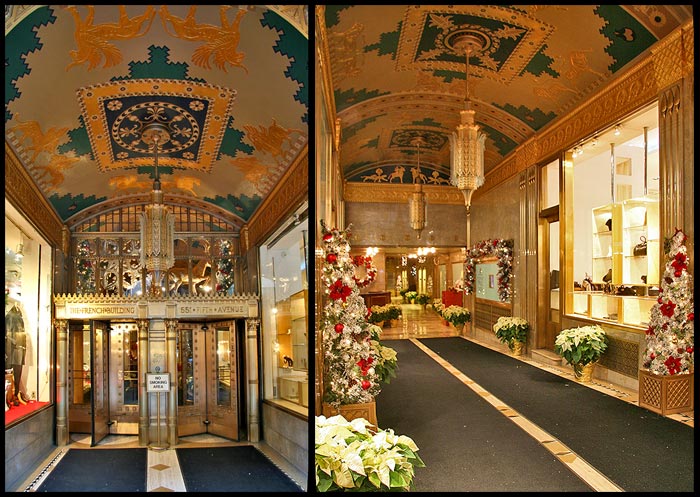 This is the vestibule and lobby of the Fred F. French building at 551 Fifth Avenue at 45th Street. They have been designated as an interior landmark. On the exterior, the 38 story art-deco building's uses a variety of materials - a limestone base, orange brickwork, terracotta decor on the setbacks, and themed rectangular panels. The structure was built in 1927 as business headquarters for real estate tycoon Fred F. French. French was a self-made man - read his rags to riches story here. He was also responsible for Tudor City and Knickerbocker Village. Tudor City was funded by selling investor shares under the "French Plan." Knickerbocker Village, a low-income publicly subsidized urban-redevelopment housing project, on the other hand, became a problem with disputes between French and his tenants - this eventually led to creation of NYC's rent-control laws. A Babylonian influence runs through the French Building and can be seen in the lobby - from New York 1930 Architecture and Urbanism Between the Two World Wars, published by Rizzoli in 1987: "inspired by the Ishtar Gate, the decorative program was a most literal evocation of Manhattan as the New Babylon, of the skyscraper as Nebuchadnezzar's hanging garden in the desert."
This is the vestibule and lobby of the Fred F. French building at 551 Fifth Avenue at 45th Street. They have been designated as an interior landmark. On the exterior, the 38 story art-deco building's uses a variety of materials - a limestone base, orange brickwork, terracotta decor on the setbacks, and themed rectangular panels. The structure was built in 1927 as business headquarters for real estate tycoon Fred F. French. French was a self-made man - read his rags to riches story here. He was also responsible for Tudor City and Knickerbocker Village. Tudor City was funded by selling investor shares under the "French Plan." Knickerbocker Village, a low-income publicly subsidized urban-redevelopment housing project, on the other hand, became a problem with disputes between French and his tenants - this eventually led to creation of NYC's rent-control laws. A Babylonian influence runs through the French Building and can be seen in the lobby - from New York 1930 Architecture and Urbanism Between the Two World Wars, published by Rizzoli in 1987: "inspired by the Ishtar Gate, the decorative program was a most literal evocation of Manhattan as the New Babylon, of the skyscraper as Nebuchadnezzar's hanging garden in the desert."
Tuesday, December 12, 2006
Nested Embraces
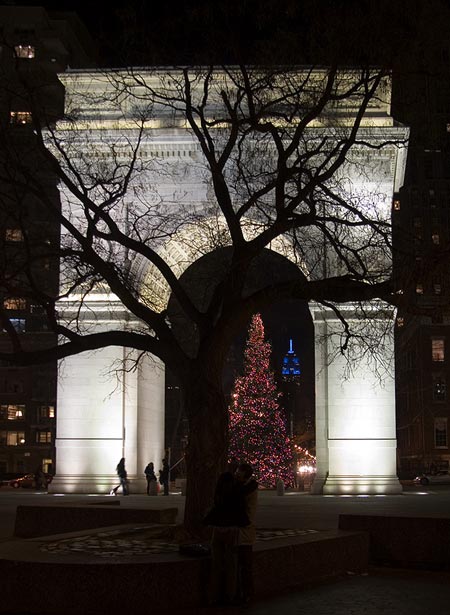 With the large, spectacular tree in Rockefeller Center, it is easy for other trees to be left out of the limelight. Washington Square Park gets its own large, 45-foot-tall tree, this year delivered from a farm in Canada, and installed centered under the arch. Click here for more photos. There was an annual tree lighting ceremony on Dec. 5th, led by Keith Borden, with the Rob Susman Brass Quartet, sponsored by the Washington Square Music Festival and the Washington Square Association. The carol singing and music is repeated on Christmas Eve. If one is fortunate, as I was, you can see the Empire State Building lit in blue (60th anniversary UNICEF) along with the Christmas tree, framed by the arch with a silhouetted tree and two lovers kissing as foreground. It was a special moment to see these nested embraces ...
With the large, spectacular tree in Rockefeller Center, it is easy for other trees to be left out of the limelight. Washington Square Park gets its own large, 45-foot-tall tree, this year delivered from a farm in Canada, and installed centered under the arch. Click here for more photos. There was an annual tree lighting ceremony on Dec. 5th, led by Keith Borden, with the Rob Susman Brass Quartet, sponsored by the Washington Square Music Festival and the Washington Square Association. The carol singing and music is repeated on Christmas Eve. If one is fortunate, as I was, you can see the Empire State Building lit in blue (60th anniversary UNICEF) along with the Christmas tree, framed by the arch with a silhouetted tree and two lovers kissing as foreground. It was a special moment to see these nested embraces ...
Monday, December 11, 2006
Gargoyles
 The most distinctive features of the Chrysler Building's exterior are the stainless steel spired crown and gargoyles based on Chrysler automobile ornaments - built from Krupp Enduro KA-2 Nirosta stainless steel. The gargoyles at the 61st Street floor setback depict American eagle hood ornaments. On the 31st floor setback, there are replicas of the radiator caps used in the late 1920s, modeled after the winged helmet of mercury. One of the most striking photographs is of Margaret Bourke-White atop one of the eagle gargoyles. Bourke-White was one of America's most distinguished photojournalists; there is a tremendous amount of material about her both on and offline - I leave it to you to peruse. The extensive use of metal on the exterior of the building, along with the ornamental references to the automobile, makes the Chrysler Building one of the enduring icons of the machine age...
The most distinctive features of the Chrysler Building's exterior are the stainless steel spired crown and gargoyles based on Chrysler automobile ornaments - built from Krupp Enduro KA-2 Nirosta stainless steel. The gargoyles at the 61st Street floor setback depict American eagle hood ornaments. On the 31st floor setback, there are replicas of the radiator caps used in the late 1920s, modeled after the winged helmet of mercury. One of the most striking photographs is of Margaret Bourke-White atop one of the eagle gargoyles. Bourke-White was one of America's most distinguished photojournalists; there is a tremendous amount of material about her both on and offline - I leave it to you to peruse. The extensive use of metal on the exterior of the building, along with the ornamental references to the automobile, makes the Chrysler Building one of the enduring icons of the machine age...
Saturday, December 09, 2006
Vista
 We New Yorkers are fortunate to have beautiful and inspiring streetscapes at nearly every turn. This vista is looking north along the Bowery from the Village. Here, we have a nice grouping of NYC landmarks: the Empire State building, of course, on the upper left; to its immediate right is the Metropolitan Life Tower (the subject of a previous post). The 4 glass pyramids are tops of the residential Zeckendorf Towers at Union Square. To the right is the Con Ed tower, headquarters of Consolidated Edison, our NYC utilities provider. The building below (with the flag atop it) is brownstone clad Cooper Union, the art, architecture and engineering college, also subject of a previous post. The city is harsh and most of us do complain - however, sights like these remind us of what we have and remind us not to become too inured or jaded...
We New Yorkers are fortunate to have beautiful and inspiring streetscapes at nearly every turn. This vista is looking north along the Bowery from the Village. Here, we have a nice grouping of NYC landmarks: the Empire State building, of course, on the upper left; to its immediate right is the Metropolitan Life Tower (the subject of a previous post). The 4 glass pyramids are tops of the residential Zeckendorf Towers at Union Square. To the right is the Con Ed tower, headquarters of Consolidated Edison, our NYC utilities provider. The building below (with the flag atop it) is brownstone clad Cooper Union, the art, architecture and engineering college, also subject of a previous post. The city is harsh and most of us do complain - however, sights like these remind us of what we have and remind us not to become too inured or jaded...
Cartier
 This is the American home of the multi-generational Cartier empire at 52nd Street and 5th Avenue, decorated for the holiday season. Cartier's is a legacy business, started in 1847. Louis Francois Cartier created the first wristwatch for a friend in 1904. This magnificent limestone structure was built for railroad investor Morton Plant in 1904, who purchased the lot from the Vanderbilts. The Vanderbilts and other wealthy residents who owned mansions in the area were not pleased when the first business (Cartier's first shop in 1909) went up on 5th Avenue. The acquisition of the Plant house by Cartier is a famous story - from the book Cartier -- Jewelers Extraordinary'' (Harry N. Abrams): ''Cartier proposed a deal in 1917 to buy the building in exchange for his most valuable two-strand pearl necklace.'' The necklace was valued at $1 million dollars at the time. The building underwent extensive renovations in 2001 and exudes old world charm - wood paneling, soft lighting etc. Click here for more photos. A visitation is de rigueur for all, especially this time of year ...
This is the American home of the multi-generational Cartier empire at 52nd Street and 5th Avenue, decorated for the holiday season. Cartier's is a legacy business, started in 1847. Louis Francois Cartier created the first wristwatch for a friend in 1904. This magnificent limestone structure was built for railroad investor Morton Plant in 1904, who purchased the lot from the Vanderbilts. The Vanderbilts and other wealthy residents who owned mansions in the area were not pleased when the first business (Cartier's first shop in 1909) went up on 5th Avenue. The acquisition of the Plant house by Cartier is a famous story - from the book Cartier -- Jewelers Extraordinary'' (Harry N. Abrams): ''Cartier proposed a deal in 1917 to buy the building in exchange for his most valuable two-strand pearl necklace.'' The necklace was valued at $1 million dollars at the time. The building underwent extensive renovations in 2001 and exudes old world charm - wood paneling, soft lighting etc. Click here for more photos. A visitation is de rigueur for all, especially this time of year ...
Friday, December 08, 2006
Little Church Around the Corner
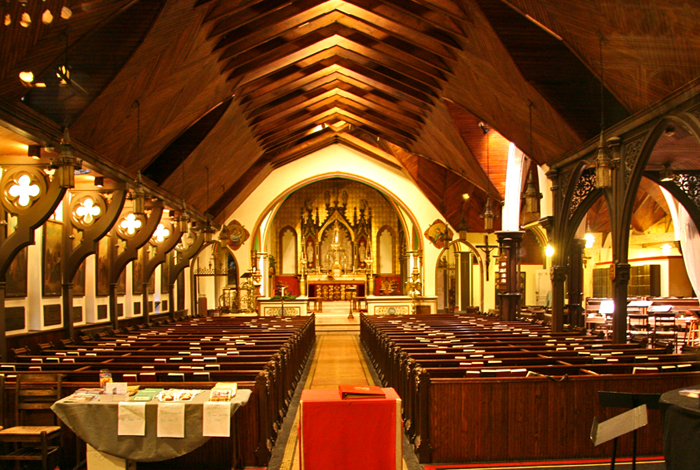 The Church of the Transfiguration is one of the most famous parishes of the Episcopal Church in the United States, known throughout the country as "The Little Church Around the Corner." For 150 years it has been a very visible worshiping community in an urban setting that has welcomed all classes, all races, and particularly all those marginalized by society for whatever reason, as were actors and actresses, who had theretofore been on the fringes of both society and the Episcopal Church. It also has stressed service to the poor and oppressed from its earliest days. The founder, Dr. Houghton sponsored bread lines and worked vigorously for the abolition of slavery and harbored runaway slaves. In 1870, when the rector of a neighboring church refused to perform a funeral for an actor name George Holland, he suggested the "little church around the corner" where "they do that sort of thing." Fellow actor Joseph Jefferson who was trying to arrange Holland's burial, exclaimed "God bless the little church around the corner!" and the church began a long standing association with people of the theater. For more information including a history, I direct you to their site. The church, at 1 E. 29th Street was built in 1849. The church is set back behind a garden - the atmosphere is one of an English parish church in the countryside. Currently, the property is undergoing extensive renovations. More photos here...
The Church of the Transfiguration is one of the most famous parishes of the Episcopal Church in the United States, known throughout the country as "The Little Church Around the Corner." For 150 years it has been a very visible worshiping community in an urban setting that has welcomed all classes, all races, and particularly all those marginalized by society for whatever reason, as were actors and actresses, who had theretofore been on the fringes of both society and the Episcopal Church. It also has stressed service to the poor and oppressed from its earliest days. The founder, Dr. Houghton sponsored bread lines and worked vigorously for the abolition of slavery and harbored runaway slaves. In 1870, when the rector of a neighboring church refused to perform a funeral for an actor name George Holland, he suggested the "little church around the corner" where "they do that sort of thing." Fellow actor Joseph Jefferson who was trying to arrange Holland's burial, exclaimed "God bless the little church around the corner!" and the church began a long standing association with people of the theater. For more information including a history, I direct you to their site. The church, at 1 E. 29th Street was built in 1849. The church is set back behind a garden - the atmosphere is one of an English parish church in the countryside. Currently, the property is undergoing extensive renovations. More photos here...
Thursday, December 07, 2006
Takashimaya
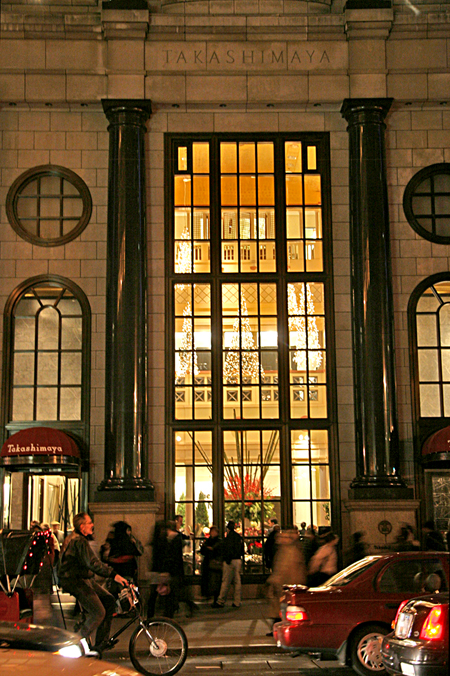 Takashimaya is much less known to residents and visitors than its neighbors on Fifth Avenue. Many people I have queried have never heard of it at all. Surprising, because it is an exquisite aesthetic experience to visit this high end retailer (perhaps not surprising - their NY website is in Japanese with no English version.) Click here for interior photos. Takashimaya NY is a mini version of the Japanese department store which was founded in Kyoto in 1829 - they have stores throughout Japan and now in New York, Taipei, Paris and Singapore. What's interesting is that Takashimaya has had a few previous small retail gift shops/salons on Fifth Ave. which were not particularly successful. In 1991 they built a 20 story building and took occupancy of the first five floors at 693 Fifth Ave. (54th-55th Streets) investing $60 million in the project. The facade is a beautiful limestone with black granite columns. The lobby has high ceilings with a beautiful flower shop with an enormous striking floral centerpiece which can be seen from the street windows. The store has an unusual selection of merchandise - each floor is a serene boutique experience. The store carries Japanese clothing, housewares and gifts and is also home to the Tea Box cafe and the Babor spa. Even if you are not a shopper, I recommend a visit ...
Takashimaya is much less known to residents and visitors than its neighbors on Fifth Avenue. Many people I have queried have never heard of it at all. Surprising, because it is an exquisite aesthetic experience to visit this high end retailer (perhaps not surprising - their NY website is in Japanese with no English version.) Click here for interior photos. Takashimaya NY is a mini version of the Japanese department store which was founded in Kyoto in 1829 - they have stores throughout Japan and now in New York, Taipei, Paris and Singapore. What's interesting is that Takashimaya has had a few previous small retail gift shops/salons on Fifth Ave. which were not particularly successful. In 1991 they built a 20 story building and took occupancy of the first five floors at 693 Fifth Ave. (54th-55th Streets) investing $60 million in the project. The facade is a beautiful limestone with black granite columns. The lobby has high ceilings with a beautiful flower shop with an enormous striking floral centerpiece which can be seen from the street windows. The store has an unusual selection of merchandise - each floor is a serene boutique experience. The store carries Japanese clothing, housewares and gifts and is also home to the Tea Box cafe and the Babor spa. Even if you are not a shopper, I recommend a visit ...
Wednesday, December 06, 2006
Step Softly
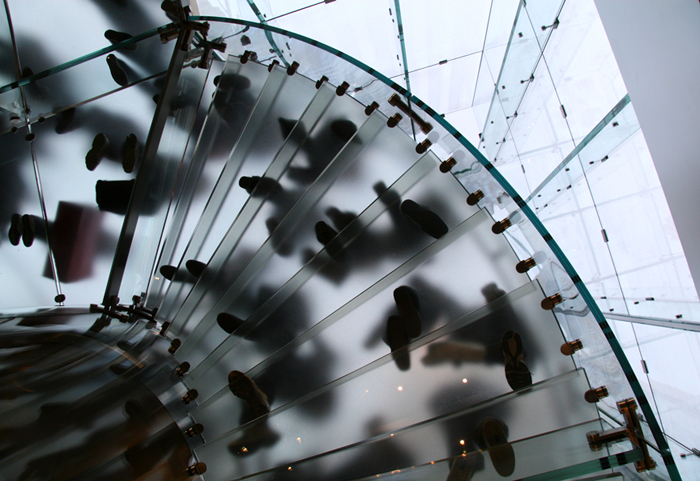 I was awed by the images created by falling and rising footsteps up and down the spiral glass staircase at the new Apple store at 59th Street and Fifth Avenue. Click here for more photos. This new store opened May 19th, 2006 with much fanfare including dozens of celebrities and CEO Steve Jobs himself. People had camped out overnight in the rain on the street for the opening at 5 PM. This location is super prime - across the street from the Plaza Hotel and Central Park - a glass cube entrance sits atop the plaza in front of the GM building and FAO Schwartz's flagship store - the 10,000 square foot retailing space itself is below street level. The store is open 24/7 365 days a year - a first for Apple. When seen lit at night, this becomes NYC's own I.M. Pei glass work. In fact, Steve Jobs has worked with Pei in the past and credits the glass pyramid entrance to the Louvre in Paris as being an influence in the store design ...
I was awed by the images created by falling and rising footsteps up and down the spiral glass staircase at the new Apple store at 59th Street and Fifth Avenue. Click here for more photos. This new store opened May 19th, 2006 with much fanfare including dozens of celebrities and CEO Steve Jobs himself. People had camped out overnight in the rain on the street for the opening at 5 PM. This location is super prime - across the street from the Plaza Hotel and Central Park - a glass cube entrance sits atop the plaza in front of the GM building and FAO Schwartz's flagship store - the 10,000 square foot retailing space itself is below street level. The store is open 24/7 365 days a year - a first for Apple. When seen lit at night, this becomes NYC's own I.M. Pei glass work. In fact, Steve Jobs has worked with Pei in the past and credits the glass pyramid entrance to the Louvre in Paris as being an influence in the store design ...
Tuesday, December 05, 2006
Atlas
 Nearly everyone is familiar with this Art Deco bronze sculpture at the Rockefeller Center complex, with Atlas shown holding up the heavens, his punishment by Zeus after his loss in the Battle of the Titans. It was created by Lee Lawrie in 1936 - he has 14 pieces attributed to him at Rockefeller Center. Lawrie (1877-1963) was born in Germany and moved to Chicago in 1882. At age 14, he began working for many sculptors in Chicago; he later moved East where his work with Ralph Adams Cram and Bertram Goodhue brought him into the artworld limelight. The sculpture sits in the small entrance courtyard to the International Building; this is a great viewing area for St. Patricks Cathedral - click here for more photos. It is interesting to note that there is a frieze on the curved beam on Atlas's shoulders which shows symbols for the planets, the moon and the 12 constellations of the zodiac. However, Pluto, discovered in 1930, is absent from the planetary group - a glaring omission given this was created in 1936. Ironically, Pluto's status as a planet is now being called into question. Another example of art predicting life?
Nearly everyone is familiar with this Art Deco bronze sculpture at the Rockefeller Center complex, with Atlas shown holding up the heavens, his punishment by Zeus after his loss in the Battle of the Titans. It was created by Lee Lawrie in 1936 - he has 14 pieces attributed to him at Rockefeller Center. Lawrie (1877-1963) was born in Germany and moved to Chicago in 1882. At age 14, he began working for many sculptors in Chicago; he later moved East where his work with Ralph Adams Cram and Bertram Goodhue brought him into the artworld limelight. The sculpture sits in the small entrance courtyard to the International Building; this is a great viewing area for St. Patricks Cathedral - click here for more photos. It is interesting to note that there is a frieze on the curved beam on Atlas's shoulders which shows symbols for the planets, the moon and the 12 constellations of the zodiac. However, Pluto, discovered in 1930, is absent from the planetary group - a glaring omission given this was created in 1936. Ironically, Pluto's status as a planet is now being called into question. Another example of art predicting life?Monday, December 04, 2006
Huddled Masses
 These may be huddled masses, but I'm not sure they're yearning to be free. Certainly not free of shopping on 5th Ave. I usually avoid such environments, but I thought capturing the hordes of holiday shoppers would depict the ultimate in cliched New York City crowds. Fifth Avenue is NYC's most upscale shopping district and one of the world's premier shopping streets, with many retailing icons (see yesterday's posting). This photo was taken on the steps of St. Patrick's cathedral at 50th Street looking south along 5th Avenue. It is now so crowded during holiday season, that police barricades have been put up for several blocks to provide additional walking space in the street itself. If you come to this area, I suggest you embrace and surrender to the experience - fighting the crowds is a no-win proposition and certainly will not lead to enjoyment of the holiday season and its festive spirit ...
These may be huddled masses, but I'm not sure they're yearning to be free. Certainly not free of shopping on 5th Ave. I usually avoid such environments, but I thought capturing the hordes of holiday shoppers would depict the ultimate in cliched New York City crowds. Fifth Avenue is NYC's most upscale shopping district and one of the world's premier shopping streets, with many retailing icons (see yesterday's posting). This photo was taken on the steps of St. Patrick's cathedral at 50th Street looking south along 5th Avenue. It is now so crowded during holiday season, that police barricades have been put up for several blocks to provide additional walking space in the street itself. If you come to this area, I suggest you embrace and surrender to the experience - fighting the crowds is a no-win proposition and certainly will not lead to enjoyment of the holiday season and its festive spirit ...
Sunday, December 03, 2006
Tiffany's Windows
 There's nothing like 5th Avenue in NYC at Christmas. I'm not a shopper, I'm not crazy about crowds but it's hard for even the hardest types to resist a little softening up when you're in an environment like this - Tiffany's, Cartier, Saks, Bergdorf Goodman, Henri Bendel, Louis Vuitton, Harry Winston, St. Patricks Cathedral, Rockefeller Center with its tree and Macys not too far away. These are not just average places at Christmas - they are classic American icons. The festive mood is everywhere - the buildings, the lights, the music and the people. Many of the Christmas window displays of the top retailers along 5th Avenue are known worldwide and millions of visitors come to see them, in some cases lines are established for viewing. The windows at Tiffany's were quite beautiful with their winter scenes and slogan: The most Beautiful Time of the Year. I imagine many would not mind sharing the jeweled setting with that snowy deer ...
There's nothing like 5th Avenue in NYC at Christmas. I'm not a shopper, I'm not crazy about crowds but it's hard for even the hardest types to resist a little softening up when you're in an environment like this - Tiffany's, Cartier, Saks, Bergdorf Goodman, Henri Bendel, Louis Vuitton, Harry Winston, St. Patricks Cathedral, Rockefeller Center with its tree and Macys not too far away. These are not just average places at Christmas - they are classic American icons. The festive mood is everywhere - the buildings, the lights, the music and the people. Many of the Christmas window displays of the top retailers along 5th Avenue are known worldwide and millions of visitors come to see them, in some cases lines are established for viewing. The windows at Tiffany's were quite beautiful with their winter scenes and slogan: The most Beautiful Time of the Year. I imagine many would not mind sharing the jeweled setting with that snowy deer ...
Saturday, December 02, 2006
Engine Company 33
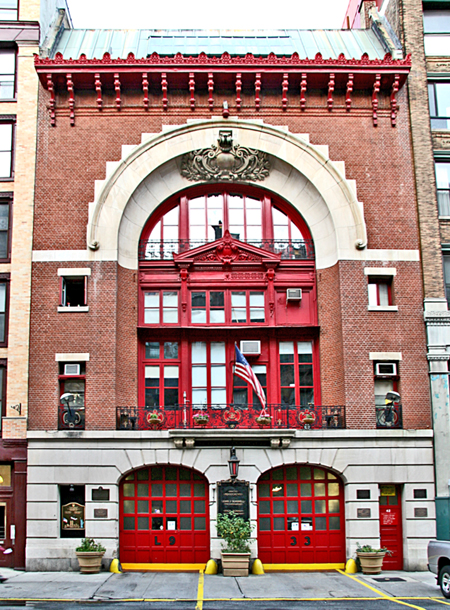 Until I began working on this website, I never paid really close attention to the firehouses of NYC. With so many distractions and so much fine architecture, it is easy to overlook things in one's travels. This firehouse, home of Engine Company Number 33 of the New York Fire Department, at 44 Great Jones in the East Village is spectacular. More photos here. It was built in 1898; designed by renowned Beaux-Arts architect Ernest Flagg who did a number of firehouses and other city landmarks. From the Guide to New York City Landmarks: "This Beaux-Art firehouse is one of the grandest small-scale civic buildings in New York City." And like all firehouses and the immediate surrounding area, it's is superbly maintained, giving the whole property a crisp quality. Engine Company 33 had the unfortunate distinction of losing 10 of the 14 firemen who went out on the 911 call ...
Until I began working on this website, I never paid really close attention to the firehouses of NYC. With so many distractions and so much fine architecture, it is easy to overlook things in one's travels. This firehouse, home of Engine Company Number 33 of the New York Fire Department, at 44 Great Jones in the East Village is spectacular. More photos here. It was built in 1898; designed by renowned Beaux-Arts architect Ernest Flagg who did a number of firehouses and other city landmarks. From the Guide to New York City Landmarks: "This Beaux-Art firehouse is one of the grandest small-scale civic buildings in New York City." And like all firehouses and the immediate surrounding area, it's is superbly maintained, giving the whole property a crisp quality. Engine Company 33 had the unfortunate distinction of losing 10 of the 14 firemen who went out on the 911 call ...
Friday, December 01, 2006
Milligan Place
 Of all the small alleys and courtyards in Manhattan, Milligan Place can perhaps be most easily missed with its small gateway sandwiched between two buildings on 6th Avenue near 10th Street in the Village. The four buildings in this cul-de-sac were built in 1852 as second-class boarding houses for waiters (primarily Basque) working at the nearby Brevoort House hotel. The land was purchased from the large Peter Warren estate in 1799 by Samuel Milligan, who built a home here. After his death in 1852, the house was replaced by the four row houses we now find here. Originally, Milligan Place was entered from Skinner Road (later named Christopher Street). In time, of course, these types of enclaves caught the fancy of the bohemian artists and later became gentrified. The cofounder of the Provincetown Players, George Cram Cook, and his wife, playwright Susan Glaspell lived here from 1913-17. Eugene O'Neill lived here as well. In 1963, an attempt to tear the buildings down (and those in nearby Patchin Place) was thwarted by a community group led by Ed Koch. Milligan Place is not so much charming for its architecture but rather for the peaceful oasis in the city it represents and that passersby may long for ...
Of all the small alleys and courtyards in Manhattan, Milligan Place can perhaps be most easily missed with its small gateway sandwiched between two buildings on 6th Avenue near 10th Street in the Village. The four buildings in this cul-de-sac were built in 1852 as second-class boarding houses for waiters (primarily Basque) working at the nearby Brevoort House hotel. The land was purchased from the large Peter Warren estate in 1799 by Samuel Milligan, who built a home here. After his death in 1852, the house was replaced by the four row houses we now find here. Originally, Milligan Place was entered from Skinner Road (later named Christopher Street). In time, of course, these types of enclaves caught the fancy of the bohemian artists and later became gentrified. The cofounder of the Provincetown Players, George Cram Cook, and his wife, playwright Susan Glaspell lived here from 1913-17. Eugene O'Neill lived here as well. In 1963, an attempt to tear the buildings down (and those in nearby Patchin Place) was thwarted by a community group led by Ed Koch. Milligan Place is not so much charming for its architecture but rather for the peaceful oasis in the city it represents and that passersby may long for ...
Subscribe to:
Posts (Atom)